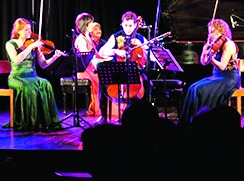
Family feuds rarely play out as pleasingly as the one at the Goethe Institut on March 24 did. The Kolkata Classics Club's Jennifer Heemstra brought together three noted musicians to recreate, through one of Brahms's finest chamber works, the 'classic family feud' between the piano on the one hand and the cello, violin and viola on the other. The concert, titled Three Strings and a Hammer, featured Heemstra on the piano, Wendy Case on the violin, Amir Eldan on the cello and Kirsten Docter on the viola; they performed the Quartet for Piano and Strings in G minor, Op. 25.
This is a sprawling four-movement work of many surprises. Heemstra began with the first theme for piano; soon, the other instruments joined in. The opening allegro is notably complex; its seemingly irregular framework makes it distinctive. Its outer sections were unrestrained, and the recapitulation blithely overlooked the structure that the exposition spelt out. This was in stark contrast to the concise, steady development. Brahms had originally devised the second movement, the intermezzo, as a brief scherzo: it is a haunting, lyrical movement, and has steadily-repeated eighth notes that conjure up a lively, almost unsettled effect.
The soaring melodic lines of the third movement - the andante - are imbued with melancholy, and serve as the emotional pinnacle of the work. This was the best performance, and laid the groundwork for the fourth movement - the rondo, nicknamed 'gypsy rondo' for its rapid, free abandon. The rondo's rhythmic and metric complexity makes it difficult to play, but the musicians, especially Eldan, infused it with shining virtuosity.
Carlos Gardel's " Por una cabeza" and Leonard Cohen's "Hallelujah" came next. As a tribute to Cohen, perhaps a lesser-known composition might have worked better. In any case, the audience came for Brahms. The piano quartet is arguably the most exhilarating piece of music he recorded on paper, but its monumental proportions often mean that people, unable to fully appreciate all the movements at one go, prefer to listen to them separately. The musicians tirelessly kept the audience enthralled; this bears testimony to their skill and stamina.










